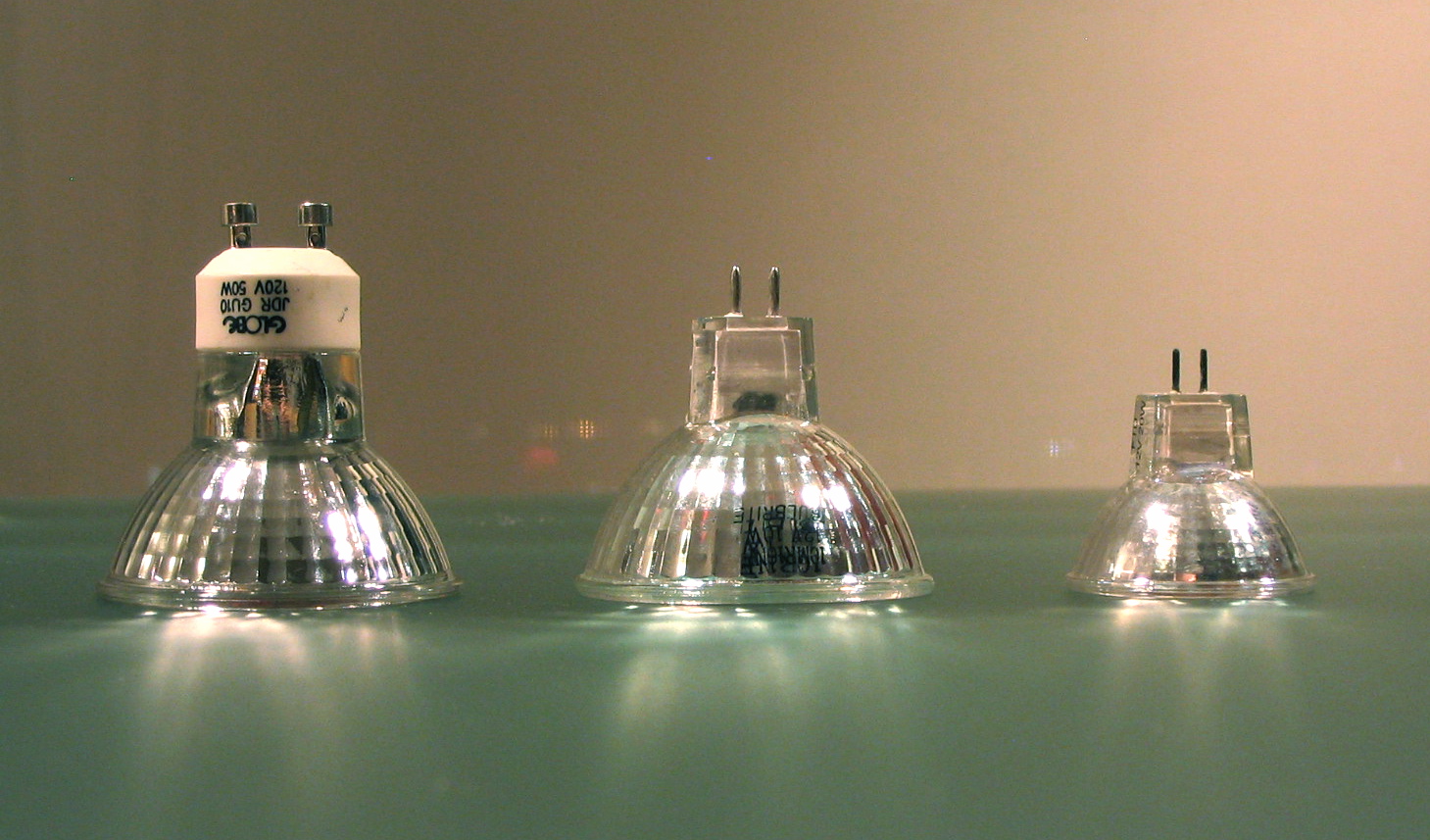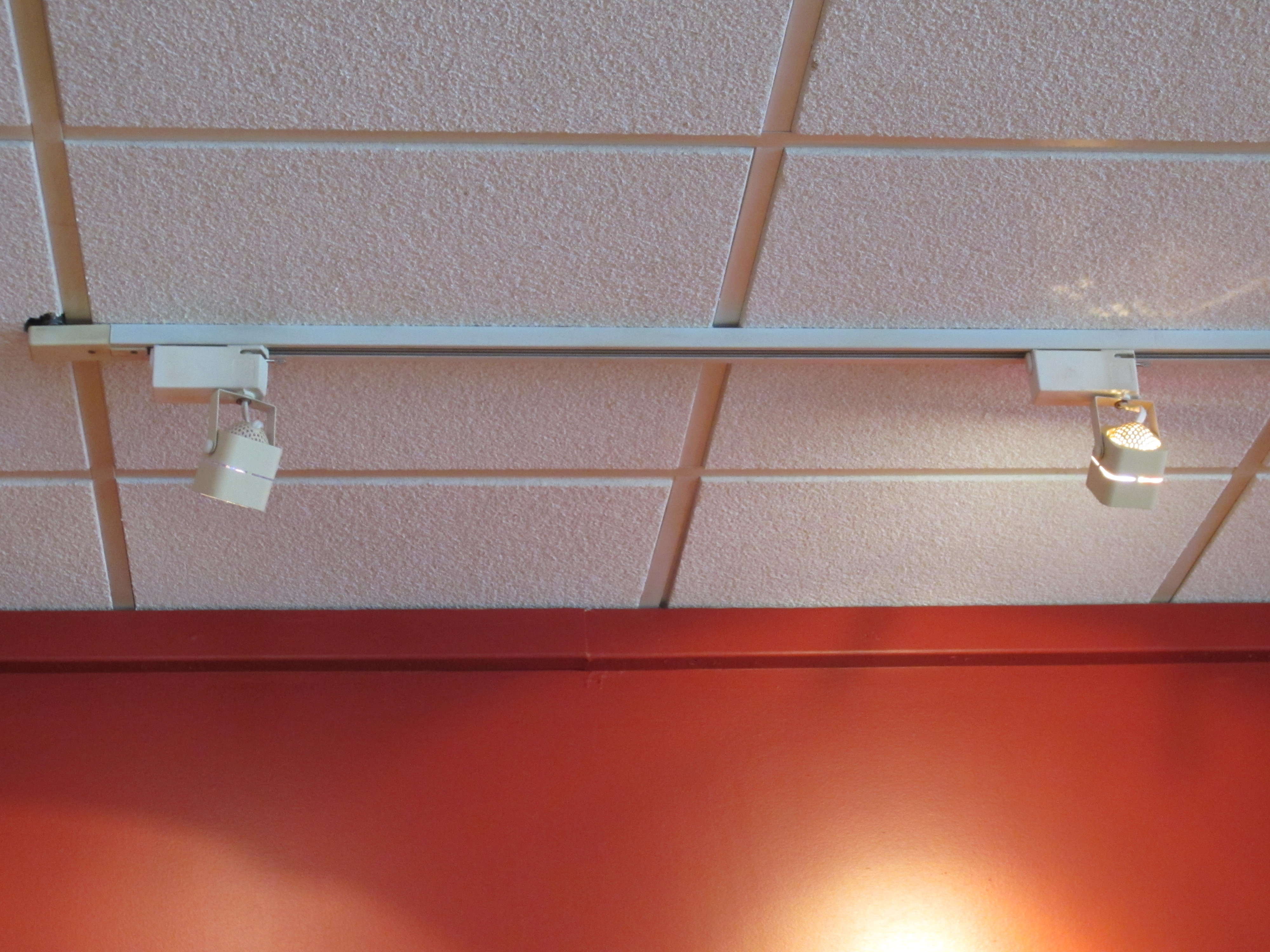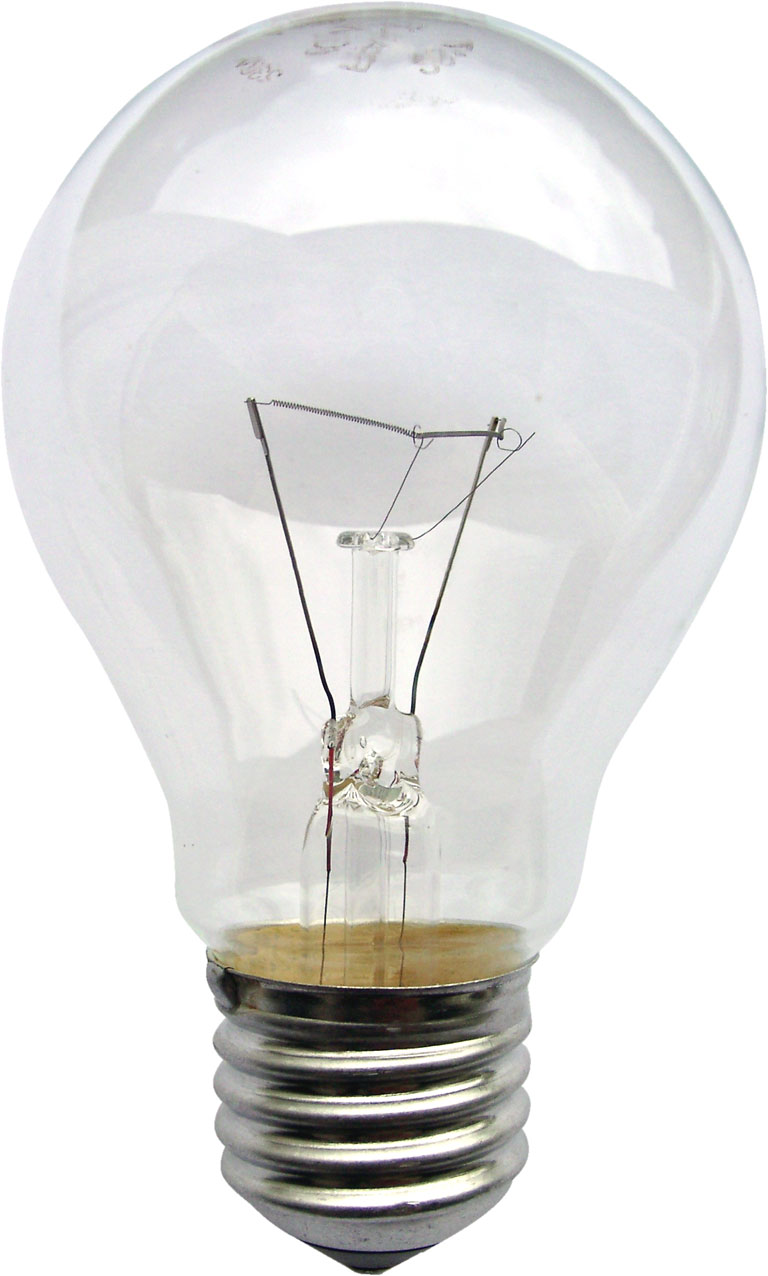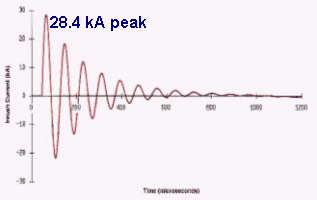|
MR16
A multifaceted reflector (often abbreviated MR) light bulb is a reflector housing format for halogen as well as some LED and fluorescent lamps. MR lamps were originally designed for use in slide projectors, but see use in residential lighting and retail lighting as well. They are suited to applications that require directional lighting such as track lighting, recessed ceiling lights, desk lamps, pendant fixtures, landscape lighting, retail display lighting, and bicycle headlights. MR lamps are designated by symbols such as ''MR16'' where the diameter is represented by numerals indicating units of eighths of an inch. Common sizes for general lighting are MR11 () and MR16 (), with MR8 () and MR20 () used in specialty applications. Many run on low voltage rather than mains voltage alternating current so require a power supply. History The MR16 lamp was first sold in 1965. Emmett H. Wiley of General Electric (USA) was awarded patent #3,314,331 for a miniature reflector lamp in 1 ... [...More Info...] [...Related Items...] OR: [Wikipedia] [Google] [Baidu] |
Bi-pin Connector
A bipin or bi-pin (sometimes referred to as two-pin, bipin cap or bipin socket) is a type of lamp fitting. They are included in the IEC standard "IEC 60061 Lamp caps and holders together with gauges for the control of interchangeability and safety". They are used on many small incandescent light bulbs (especially halogen lamps), and for starters on some types of fluorescent lights. Some sockets have pins placed closer together, preventing the low-power bulbs they use from being replaced by bulbs that are too high power, which may generate excessive heat and possibly cause a fire. These are sometimes called "mini-bipin". Where the terminals of the lamp are bent back onto the sides of the base of the bulb, this forms a wedge base, often used in small bulbs for automotive lighting. The bi-pin base was invented by Reginald Fessenden for the 1893 World's Fair in Chicago. After Westinghouse won the contract to wire and illuminate the first electrified fair with AC inste ... [...More Info...] [...Related Items...] OR: [Wikipedia] [Google] [Baidu] |
Bi-pin
A bipin or bi-pin (sometimes referred to as two-pin, bipin cap or bipin socket) is a type of lamp fitting. They are included in the IEC standard "IEC 60061 Lamp caps and holders together with gauges for the control of interchangeability and safety". They are used on many small incandescent light bulbs (especially halogen lamps), and for starters on some types of fluorescent lights. Some sockets have pins placed closer together, preventing the low-power bulbs they use from being replaced by bulbs that are too high power, which may generate excessive heat and possibly cause a fire. These are sometimes called "mini-bipin". Where the terminals of the lamp are bent back onto the sides of the base of the bulb, this forms a wedge base, often used in small bulbs for automotive lighting. The bi-pin base was invented by Reginald Fessenden for the 1893 World's Fair in Chicago. After Westinghouse won the contract to wire and illuminate the first electrified fair with AC instead of a ... [...More Info...] [...Related Items...] OR: [Wikipedia] [Google] [Baidu] |
Track Lighting
Track lighting is a method of lighting where light fixtures are attached anywhere on a continuous track device which contains electrical conductors. This is in contrast to directly routing electrical wiring to individual light positions. Tracks can either be mounted to ceilings or walls, lengthwise down Beam (structure), beams, or across rafters or joists. They can also be hung with rods from especially high places like vaulted ceilings. Track lighting was invented by Anthony Donato of Lightolier. Donato received the first patent related to track lighting in 1961. Tracks There are multiple types of tracks used worldwide, for example: * ERCO * Eutrac * GLOBAL Trac * Halo (lighting brand), Halo * Ivela (lighting brand), Ivela * Juno (lighting brand), Juno * Lightolier Typical systems have Mains electricity, line voltage running through a recessed track. The track may have more than one live conductor, so that multiple switched circuits can be used to control different fittings ... [...More Info...] [...Related Items...] OR: [Wikipedia] [Google] [Baidu] |
Edison Screw
Edison screw (ES) is a standard lightbulb socket for electric light bulbs. It was developed by Thomas Edison (1847–1931), patented in 1881, and was licensed in 1909 under General Electric's Mazda (light bulb), Mazda trademark. The bulbs have Screw thread#Handedness, right-hand threaded metal bases (caps) which screw into matching threaded sockets (lamp holders). For bulbs powered by Single-phase electric power, AC current, the thread is generally connected to Ground and neutral, neutral and the contact on the bottom tip of the base is connected to the "live" phase. In North America and continental Europe, Edison screws displaced other socket types for general lighting. In the early days of electrification, Edison screws were the only standard connector, and appliances other than light bulbs were connected to AC power via lamp sockets. Today Edison screw sockets comply with international standards. Their types are designated as "Exx", such as "E26", where "xx" indicates the dia ... [...More Info...] [...Related Items...] OR: [Wikipedia] [Google] [Baidu] |
Color Temperature
Color temperature is a parameter describing the color of a visible light source by comparing it to the color of light emitted by an idealized opaque, non-reflective body. The temperature of the ideal emitter that matches the color most closely is defined as the color temperature of the original visible light source. The color temperature scale describes only the ''color'' of light emitted by a light source, which may actually be at a different (and often much lower) temperature. Color temperature has applications in lighting, photography, videography, publishing, manufacturing, astrophysics, and other fields. In practice, color temperature is most meaningful for light sources that correspond somewhat closely to the color of some black body, i.e., light in a range going from red to orange to yellow to white to bluish white. Although the concept of correlated color temperature extends the definition to any visible light, the color temperature of a green or a purple light rar ... [...More Info...] [...Related Items...] OR: [Wikipedia] [Google] [Baidu] |
Gas Discharge Lamp
Gas-discharge lamps are a family of artificial light sources that generate light by sending an electric discharge through an ionized gas, a plasma. Typically, such lamps use a noble gas (argon, neon, krypton, and xenon) or a mixture of these gases. Some include additional substances, such as mercury, sodium, and metal halides, which are vaporized during start-up to become part of the gas mixture. Single-ended self-starting lamps are insulated with a mica disc and contained in a borosilicate glass gas discharge tube (arc tube) and a metal cap. They include the sodium-vapor lamp that is the gas-discharge lamp in street lighting. In operation, some of the electrons are forced to leave the atoms of the gas near the anode by the electric field applied between the two electrodes, leaving these atoms positively ionized. The free electrons thus released flow to the anode, while the cations thus formed are accelerated by the electric field and flow towards the cathode. The ions ty ... [...More Info...] [...Related Items...] OR: [Wikipedia] [Google] [Baidu] |
Transformer
In electrical engineering, a transformer is a passive component that transfers electrical energy from one electrical circuit to another circuit, or multiple Electrical network, circuits. A varying current in any coil of the transformer produces a varying magnetic flux in the transformer's core, which induces a varying electromotive force, electromotive force (EMF) across any other coils wound around the same core. Electrical energy can be transferred between separate coils without a metallic (conductive) connection between the two circuits. Faraday's law of induction, discovered in 1831, describes the induced voltage effect in any coil due to a changing magnetic flux encircled by the coil. Transformers are used to change Alternating current, AC voltage levels, such transformers being termed step-up or step-down type to increase or decrease voltage level, respectively. Transformers can also be used to provide galvanic isolation between circuits as well as to couple stages of signa ... [...More Info...] [...Related Items...] OR: [Wikipedia] [Google] [Baidu] |
Inrush Current
Inrush current, input surge current, or switch-on surge is the maximal instantaneous input current drawn by an electrical device when first turned on. Alternating-current electric motors and transformers may draw several times their normal full-load current when first energized, for a few cycles of the input waveform. Power converters also often have inrush currents much higher than their steady-state currents, due to the charging current of the input capacitance. The selection of over-current-protection devices such as fuses and circuit breakers is made more complicated when high inrush currents must be tolerated. The over-current protection must react quickly to overload or short-circuit faults but must not interrupt the circuit when the (usually harmless) inrush current flows. Capacitors A discharged or partially charged capacitor appears as a short circuit to the source when the source voltage is higher than the potential of the capacitor. A fully discharged capacitor will tak ... [...More Info...] [...Related Items...] OR: [Wikipedia] [Google] [Baidu] |
Ultraviolet
Ultraviolet radiation, also known as simply UV, is electromagnetic radiation of wavelengths of 10–400 nanometers, shorter than that of visible light, but longer than X-rays. UV radiation is present in sunlight and constitutes about 10% of the total electromagnetic radiation output from the Sun. It is also produced by electric arcs, Cherenkov radiation, and specialized lights, such as mercury-vapor lamps, tanning lamps, and black lights. The photons of ultraviolet have greater energy than those of visible light, from about 3.1 to 12 electron volts, around the minimum energy required to ionize atoms. Although long-wavelength ultraviolet is not considered an ionizing radiation because its photons lack sufficient energy, it can induce chemical reactions and cause many substances to glow or fluoresce. Many practical applications, including chemical and biological effects, are derived from the way that UV radiation can interact with organic molecules. The ... [...More Info...] [...Related Items...] OR: [Wikipedia] [Google] [Baidu] |
Dimmer
A dimmer is a device connected to a light fixture and used to lower the brightness of the Lighting, light. By changing the voltage waveform applied to the lamp, it is possible to lower the Luminous intensity, intensity of the light output. Although variable-voltage devices are used for various purposes, the term ''dimmer'' is generally reserved for those intended to lighting control system, control light output from resistive Incandescent light, incandescent, Halogen lamp, halogen, and (more recently) compact fluorescent lamps (CFLs) and light-emitting diodes (LED lamp, LEDs). More specialized equipment is needed to dim Fluorescent lamp, fluorescent, Mercury-vapor lamp, mercury-vapor, Solid-state lighting, solid-state, and other Arc lamp, arc lighting. Dimmers range in size from small units the size of domestic light switches to high-power units used in large theatrical or architectural lighting design, architectural lighting installations. Small domestic dimmers are generally ... [...More Info...] [...Related Items...] OR: [Wikipedia] [Google] [Baidu] |







